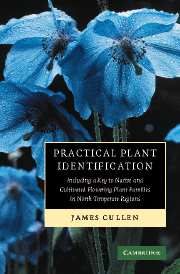 Practical Plant Identification
Practical Plant Identification Book contents
- Frontmatter
- Contents
- List of illustrations
- Preface
- Acknowledgements
- Introduction
- Examining the plant: a brief survey of plant structure and its associated terminology
- Using the keys
- Keys
- ‘Spot’ characters
- Arrangement and description of families
- Further identification and annotated bibliography
- Glossary
- Index
Arrangement and description of families
Published online by Cambridge University Press: 02 December 2009
- Frontmatter
- Contents
- List of illustrations
- Preface
- Acknowledgements
- Introduction
- Examining the plant: a brief survey of plant structure and its associated terminology
- Using the keys
- Keys
- ‘Spot’ characters
- Arrangement and description of families
- Further identification and annotated bibliography
- Glossary
- Index
Summary
In general, the variation given in the descriptions is somewhat wider than that presented in the key, and many characters used in the latter have had to be omitted. In using the descriptions, the following features must be assumed for most species of a family, unless otherwise stated: milky sap absent, habit not succulent, parts of the flower free from each other, stamens not antepetalous, and anthers opening by longitudinal slits. The ptyxis, as far as it is known, is given for each family: this refers to leaves if they are undivided, to leaflets if the leaves are divided.
The families are listed in the xorder of the Melchior system (see p. 3). No attempt has been made to group them into suprafamilial units (‘orders’), as these have no significance for practical identification.
The following points concerned with presentation should be noted.
Morphology
The oblique stroke (/) is used instead of ‘or’; the letter ‘n’ is used instead of ‘many’ or ‘numerous’ (i.e. more than 10 or 12). Abbreviations: K, calyx-segments or sepals; C, corolla-segments or petals; P, perianth-segments when these are undifferentiated; A, stamens; G, carpels. These letters are also used in the collective sense; for example, ‘A antepetalous’ means stamens antepetalous. Brackets are used to indicate that the segments of any particular whorl are united to each other; for example, C(5) means a corolla of 5 lobes united below into a cup or tube.
- Type
- Chapter
- Information
- Practical Plant IdentificationIncluding a Key to Native and Cultivated Flowering Plants in North Temperate Regions, pp. 123 - 259Publisher: Cambridge University PressPrint publication year: 2006
